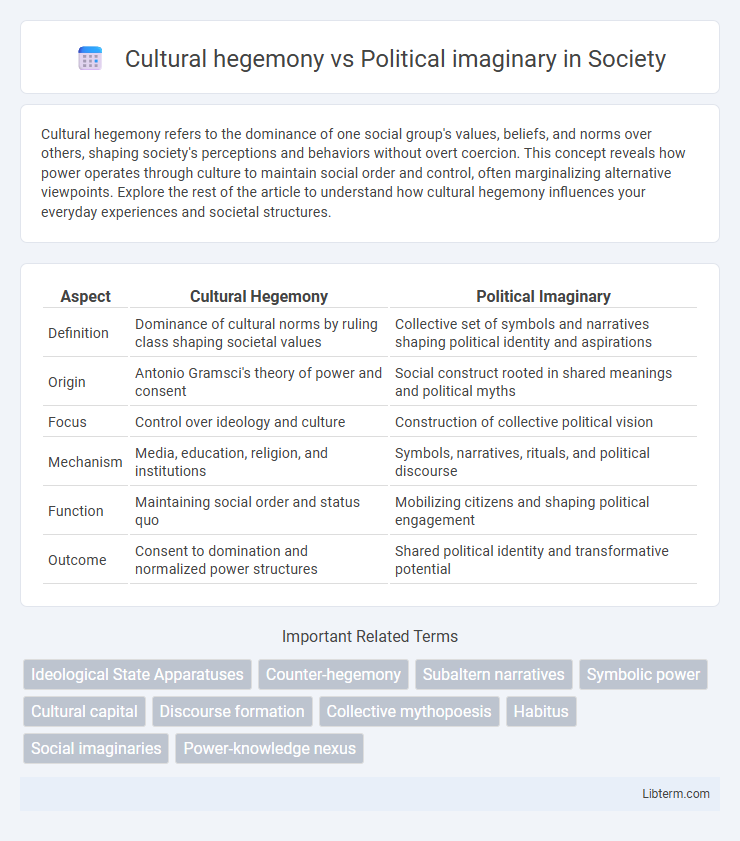Cultural hegemony refers to the dominance of one social group's values, beliefs, and norms over others, shaping society's perceptions and behaviors without overt coercion. This concept reveals how power operates through culture to maintain social order and control, often marginalizing alternative viewpoints. Explore the rest of the article to understand how cultural hegemony influences your everyday experiences and societal structures.
Table of Comparison
| Aspect | Cultural Hegemony | Political Imaginary |
|---|---|---|
| Definition | Dominance of cultural norms by ruling class shaping societal values | Collective set of symbols and narratives shaping political identity and aspirations |
| Origin | Antonio Gramsci's theory of power and consent | Social construct rooted in shared meanings and political myths |
| Focus | Control over ideology and culture | Construction of collective political vision |
| Mechanism | Media, education, religion, and institutions | Symbols, narratives, rituals, and political discourse |
| Function | Maintaining social order and status quo | Mobilizing citizens and shaping political engagement |
| Outcome | Consent to domination and normalized power structures | Shared political identity and transformative potential |
Defining Cultural Hegemony: Power and Consent
Cultural hegemony refers to the domination of a culturally diverse society by the ruling class's worldview, which becomes the accepted cultural norm and ideology, shaping beliefs and values through power and consent. This concept, developed by Antonio Gramsci, emphasizes that power is maintained not just through force, but through the consent of the subordinated classes who internalize the dominant ideology. The process of cultural hegemony establishes a political imaginary where social structures and norms appear natural and inevitable, reinforcing existing power relations.
Understanding the Political Imaginary: Vision and Possibility
The political imaginary shapes collective visions and possibilities, influencing how societies conceptualize power, identity, and social order beyond mere structures of domination found in cultural hegemony. It encompasses symbols, myths, and narratives that inspire political engagement and transform societal goals, offering dynamic frameworks for envisioning alternative futures. Understanding the political imaginary reveals the deep-rooted cultural resources that enable transformative political action and reimagine hegemonic power relations.
Historical Roots: From Gramsci to Contemporary Thought
Cultural hegemony, a concept developed by Antonio Gramsci, refers to the dominance of a ruling class's worldview shaping societal norms and values, embedding power through consensual cultural institutions rather than direct force. The political imaginary encompasses the collective set of ideas, images, and narratives through which societies envision political organization and authority, influenced by historical contexts and ideological frameworks. Contemporary thought expands on Gramsci's foundation, exploring how cultural hegemony interacts with evolving political imaginaries to sustain or challenge power structures in globalized, media-driven societies.
Mechanisms of Influence: How Hegemony Shapes Beliefs
Cultural hegemony shapes beliefs through dominant ideologies embedded in everyday practices, media, and education, subtly reinforcing the ruling class's worldview as common sense. Political imaginary, in contrast, operates by constructing collective visions and narratives that inspire political action and identity formation. The mechanisms of influence in hegemony rely on normalization and consent, while political imaginary mobilizes symbolic meanings to challenge or sustain power structures.
The Role of Media in Cultural Hegemony
Media serves as a critical instrument in perpetuating cultural hegemony by shaping public perceptions and reinforcing dominant ideologies through selective representation and framing. By controlling narratives and disseminating culturally normative values, media institutions influence societal consensus, marginalizing alternative viewpoints and maintaining existing power structures. The politicization of imagery and content within media reinforces hegemonic control, embedding political imaginaries in everyday consciousness that align with ruling interests.
Political Imaginary as a Catalyst for Social Change
Political imaginary serves as a transformative catalyst for social change by shaping collective aspirations and challenging dominant cultural hegemonies that maintain existing power structures. It constructs alternative narratives and visions of society, enabling marginalized groups to envision and mobilize for new political realities beyond the constraints imposed by cultural hegemony. Through symbolic representation and shared meanings, the political imaginary fosters social movements that disrupt hegemonic ideologies and promote democratic transformation.
Points of Intersection: Where Hegemony Meets Imaginary
Cultural hegemony and political imaginary intersect in shaping collective consciousness and societal norms through dominant ideologies that define power structures and social realities. The political imaginary functions as a lens through which cultural hegemony materializes by embedding ruling-class values into public perception, thereby legitimizing authority and sustaining social order. This confluence reveals how hegemonic narratives are internalized within political imaginaries to orchestrate social compliance and cultural cohesion.
Resistance and Counter-Hegemonies
Cultural hegemony, as theorized by Antonio Gramsci, emphasizes the dominance of ruling class ideologies that shape societal norms and maintain power structures through consent rather than coercion. Political imaginary refers to the collective visions and narratives that inspire political action and frame alternative possibilities for social organization. Resistance and counter-hegemonies emerge as contestations to dominant cultural narratives, mobilizing marginalized groups to challenge and propose new frameworks that disrupt established power relations and envision transformative social change.
Implications for Democracy and Governance
Cultural hegemony shapes public perception by embedding dominant ideologies into social institutions, subtly influencing democratic participation and limiting pluralism. Political imaginary, the collective vision of societal possibilities, drives governance by framing citizens' expectations and legitimizing political authority. The interplay between cultural hegemony and political imaginary affects democratic resilience, potentially reinforcing power structures while constraining inclusive policy-making.
Future Directions: Rethinking Power and Imagination
Future directions in exploring cultural hegemony and political imaginary emphasize rethinking the interplay between power structures and collective imagination to foster more inclusive and transformative social narratives. Scholars advocate for integrating interdisciplinary approaches that challenge dominant hegemonies by amplifying marginalized voices and envisioning alternative political futures. Emerging research highlights the potential of digital media and grassroots movements to reshape political imaginaries, enabling dynamic contests of power and identity in an increasingly interconnected world.
Cultural hegemony Infographic

 libterm.com
libterm.com